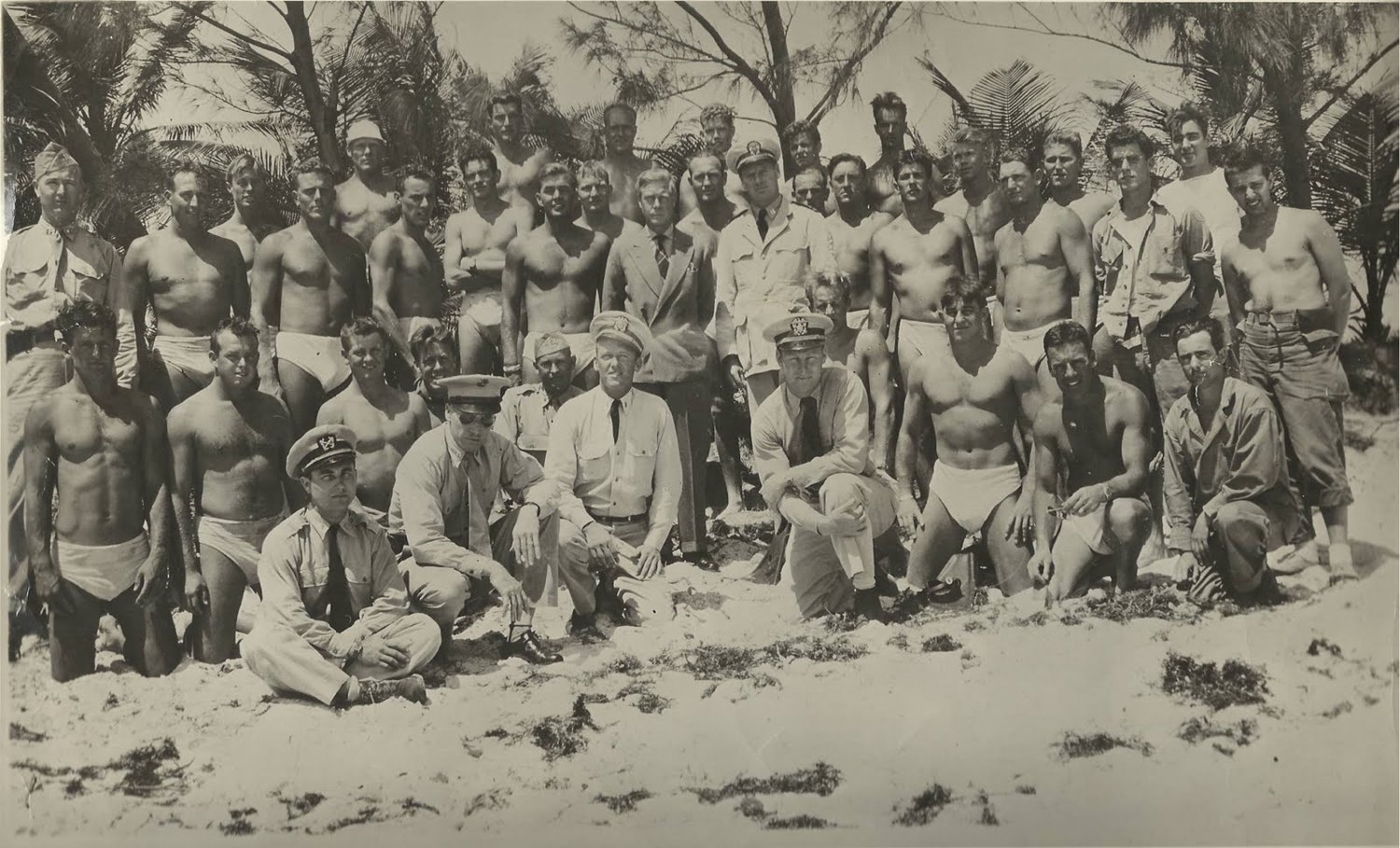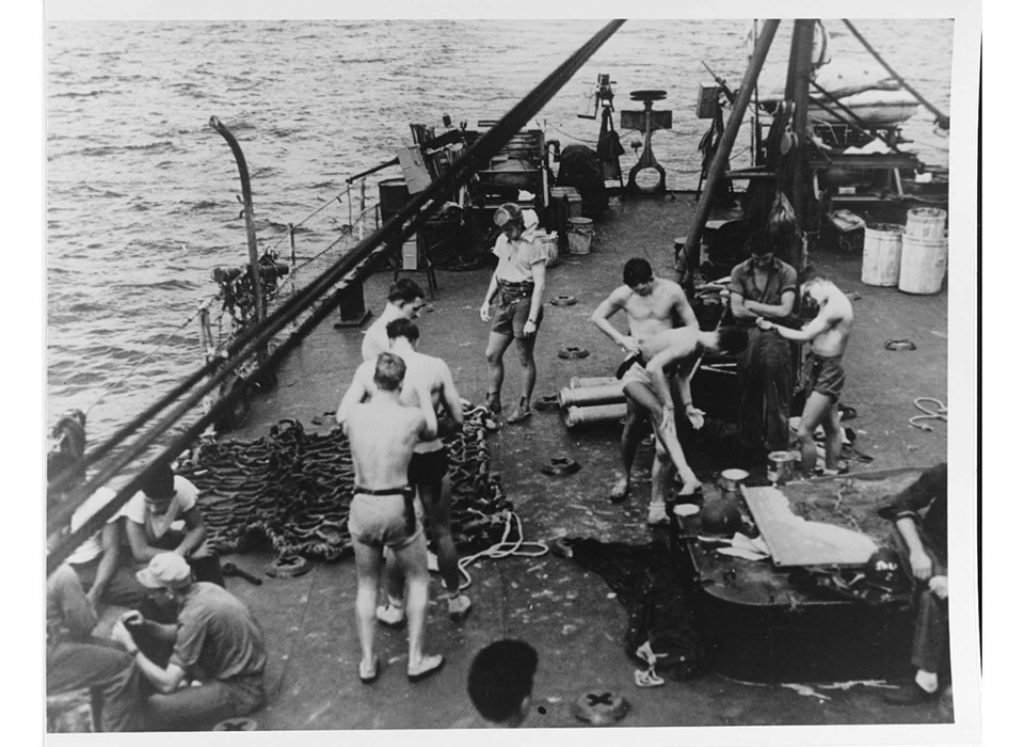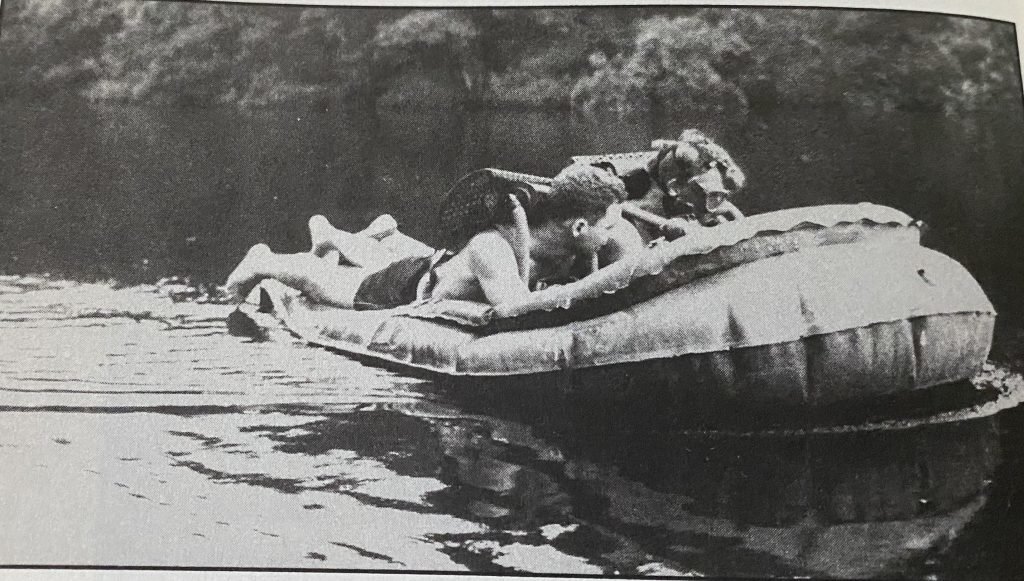The Battle of Saipan: How Frogmen Provided Safe Passage for Amphibious Landings

Draper Kauffman pictured center with members of the U.S. Navy’s Underwater Demolition Teams. Photo courtesy of https://www.sealtwo.org/interesting-stuff-02/
Modern day U.S. Navy SEALs have the latest and greatest diving equipment including wetsuits, rebreather oxygen tanks, GPS devices, and all sorts of technology that increases the success of maritime operations. However, during the island-hopping campaigns in the Pacific during World War II, members of the Navy’s Underwater Demolition Teams (UDTs) were equipped with nothing more than a dive mask, a pair of canvas shoes, a knife, and a satchel of explosives strapped to their backs.
Traveling aboard one of several landing crafts was Draper Kauffman, the commanding officer of UDT-5. He was tasked with leading a daylight reconnaissance mission to survey a nearby reef located along the beaches off Charan-Kanoa, Saipan Island, ahead of the invasion the following day.
U.S. military lessons are often written in blood. When the U.S. Marines conducted an amphibious landing on the Tarawa Atoll in the Gilbert Islands on Nov. 22, 1943, disaster struck when their landing crafts were immobilized by a hidden and submerged coral reef. While the landing crafts tried to fix the problem, hundreds of Marines drowned or were killed when machine guns erupted from the beach.

The day before thousands of Marines would assault the beaches of Saipan on June 15, 1944, Kauffman’s frogmen disembarked from their landing crafts in pairs and laid across “flying mattresses” — 8-foot-long air mattresses equipped with battery-powered propellers — and motored toward the shore.
Small-arms fire from the beach raked through the waves, barely missing their rubber boats. “Mostly it was machine guns that were firing at us,” said Robert Marshall, a UDT frogmen on the mission. “The bullets would only zip into the water a couple of feet and then just sink to the bottom. A number of them dropped past my face as I was swimming underwater.”
The harrowing 9 AM reconnaissance wasn’t a surprise to the Japanese, and they expected this was the first phase of the invasion. The frogmen slipped off of their inflatable flying mattresses using the waves to temporarily conceal themselves as they swam nearly 1,000 yards toward the beach. Completely exposed to enemy fire, the combat swimmers expected to have close-air support to strafe the beach and naval battleships to bombard emplaced Japanese trenches and pillboxes an hour into the recon, but only the battleships followed the plan.
“Not one plane arrived,” Kauffman later wrote, describing the lack of support for his UDT unit. “I got to about 100 yards from the beach, and even with my bad eyes I could see the Japs moving around, manning their bloody machineguns.”

Bob Christensten, a 22-year-old shipfitter first class, was tragically shot and killed. Harold Hall Jr., one of the combat swimmers, was lifted completely out of the water from an underwater air burst explosion fired from a Japanese mortar position. “I was on deck, lying on a cot for about eight or nine days before I could move,” Hall said, discussing his recovery after he made it back onto one of the landing crafts. “If I moved, I felt nauseous.”
Despite not everything going according to plan, the frogmen were able to provide the task force commander with valuable intelligence concerning the shoreline along Red Beach 2. It was determined to be two feet deeper than what allied imagery from the air had suggested. The frogmen were able to measure these shallow water depths by using a primitive method of labeled stripes along their bodies to mark the height of the water. These measurements would later help the amphibious assault force in navigating their tanks to the correct lanes along the beach.
The reconnaissance mission was largely deemed a success, and Kauffman was awarded his second Navy Cross for his efforts in leading the mission and later for returning and rescuing two UDT frogmen who were declared missing in action. Hall however, never received a Purple Heart for being wounded in action. “No one knew what the hell was going on,” Hall said. “Right now, I can still feel the buzz from the bomb.” Hall, a Rhode Island resident and native of Hingham, Massachusetts, has outlived every member of UDT-5 and believes many World War II veterans were not properly recognized with Purple Hearts for receiving traumatic brain injuries during the war. “If I’d have died,” he said, laughing, “I would have gotten it.”
The frogmen of UDT-5 helped support the invasion where U.S. Marines fought a desperate and bloody three-week battle killing some 27,000 Japanese while sustaining an estimated 16,000 casualties of their own before the battle was over.

Matt Fratus is a history staff writer for Coffee or Die. He prides himself on uncovering the most fascinating tales of history by sharing them through any means of engaging storytelling. He writes for his micro-blog @LateNightHistory on Instagram, where he shares the story behind the image. He is also the host of the Late Night History podcast. When not writing about history, Matt enjoys volunteering for One More Wave and rooting for Boston sports teams.
BRCC and Bad Moon Print Press team up for an exclusive, limited-edition T-shirt design!
BRCC partners with Team Room Design for an exclusive T-shirt release!
Thirty Seconds Out has partnered with BRCC for an exclusive shirt design invoking the God of Winter.
Lucas O'Hara of Grizzly Forge has teamed up with BRCC for a badass, exclusive Shirt Club T-shirt design featuring his most popular knife and tiomahawk.
Coffee or Die sits down with one of the graphic designers behind Black Rifle Coffee's signature look and vibe.
Biden will award the Medal of Honor to a Vietnam War Army helicopter pilot who risked his life to save a reconnaissance team from almost certain death.
Ever wonder how much Jack Mandaville would f*ck sh*t up if he went back in time? The American Revolution didn't even see him coming.
A nearly 200-year-old West Point time capsule that at first appeared to yield little more than dust contains hidden treasure, the US Military Academy said.












